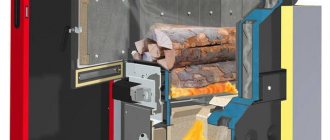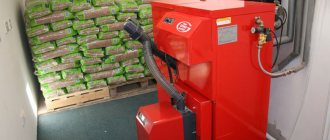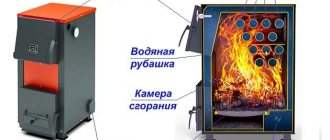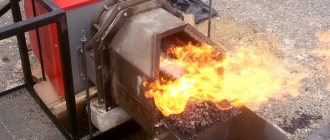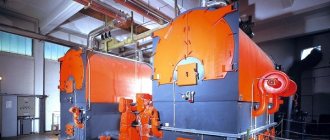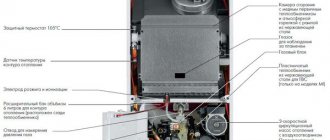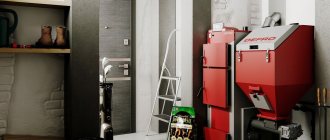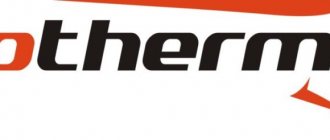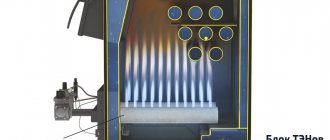Step-by-step manufacturing instructions
The process of creating a heating device is quite simple and takes place in several successive stages.
First, the body of the structure is made:
- Two large diameter pipes (50 and 45 cm) are inserted into each other and connected using a metal ring.
- A circle of metal with a diameter of 45 cm is cut out of a pre-prepared sheet, which is used to weld the bottom of a smaller pipe located inside the structure. As a result, we get a barrel with a diameter of 45 cm, with a welded hot water jacket-contour 2.5 cm wide.
- A rectangular hole is cut at the bottom of the “barrel”. Height - up to 10 cm, width - about 15. It will be used as an ash pan door. A hatch is welded in, a door with attached hinges and a latch is installed.
- A rectangular hole is cut in the upper part of the circuit to supply solid fuel. The size is selected individually, the main condition is the convenience of loading firewood. The hatch is welded. A door equipped with hinges and a latch is installed. It is made double: an asbestos layer is laid between individual metal sheets, and the contact areas are sealed with asbestos cord. Thanks to such manipulations, heat loss from the boiler is reduced.
- At the upper level, an exhaust pipe is installed that discharges exhaust gases into the chimney.
- In two places (top and bottom) of the water circuit, pipes with a diameter of 4–5 cm are welded, which are necessary to connect the boiler to a further heating system. The thread is cut, for which a groove is used.
- Checking welding seams and, if necessary, eliminating flaws.
After creating the metal body of the solid fuel boiler, you can begin to manufacture and install the air distributor:
The air distributor can be made in the form of a pancake with welded channels
- A metal circle is cut out. Its diameter should be several centimeters smaller than the internal one on the boiler. A round hole is cut in the center of the circle, the size corresponding to the air distributor pipe (5–6 centimeters).
- A metal tube is inserted into the cut hole.
- Channels or corners arranged in the form of blades are welded onto the “pancake” from below. If the thickness of the blades is suitable, an impeller from a fan is sometimes used.
- A small loop is welded on top. With its help you can raise and lower the distributor. A damper is also equipped to regulate the intensity of air supply to the fire zone.
- Installation of the air distributor to the housing. A circle is cut out of a metal sheet, the diameter of which is equal to the outer body. A 6–8 cm hole is cut in the center. The lower part of the air distributor is inserted into the boiler, the upper part is threaded through the hole. After this, the circle is welded to the boiler and subsequently functions as a top cover.
This is one of the simplest ways to make a solid fuel boiler. There are complicated circuits used in industrial and household models.
Calculation of the minimum required power
Correct calculation of power will allow you to survive any frost without worries and always have warm water in sufficient quantities. The minimum required power is calculated at the rate of 1 kW per 10 m2 of heated area for a standard house with 2 bricks and a ceiling height of no more than 2.7 meters.
According to the technology, calculations are carried out separately for each room, but in practice the total area is often divided by 10 and multiplied by 1 kW. Then losses and calculation inaccuracies are added to increase the received power by 20%; if a DHW circuit is also planned, it is necessary to add another 20% reserve.
Excessive power results in underutilization of the boiler, but retains the opportunity to expand its use in the future. An error in lack of power promises a loss of comfort and an inevitable rework of the heating system.
This is largely an approximate calculation; for an accurate calculation, you can involve a heating engineer or, based on SNiP 2.04.01-85, you can recalculate the hot water consumption in accordance with the standards, but you will still have to take into account the safety margin, and such an estimate will have little effect on the choice of a specific model. For a private house up to 400 m2, in more than 90% of cases the simple calculation given above is sufficient.
How to calculate the required boiler power Individual calculation, formula and correction factors
Peculiarities
In a modern private home, many people try to use gas or even electric boilers. This is understandable: such equipment is automated and quite easy to use. But the classic design - a solid fuel boiler - also does not give up its position so easily.
Moreover, now this heating method is gradually gaining popularity. Gas cannot be extended everywhere, just like electricity; connecting to the appropriate networks is expensive, and the stability of their operation, even in the most developed areas, can be disrupted by bad weather, technical failure, or the actions of intruders.
Solid fuel boilers are made of cast iron or steel, but it is impossible to say in advance which of the two materials will be better in a particular case. The fragility of cast iron does not prevent it from serving for a very long time and retaining the generated heat for a long time.
However, relatively short-lived steel has its own arguments: increased strength and faster heating of housing.
Returning to the heat exchanger material, it is worth emphasizing that steel tolerates temperature fluctuations better, and cast iron is more resistant to corrosion. Steel products are lighter than cast iron, but the connection is made using welding, and it has long been known that every welded joint is a weak point of the structure in which it was made. The skill of welders and careful adherence to technology reduce losses, but cannot prevent them completely.
There is little point in supplementing a single-circuit boiler with a water tank. A more correct step is to purchase a full-fledged unit with two circuits. Ultimately, installing additional tanks costs money and takes up unnecessary time. If you need to purchase a boiler with increased power, you need to choose a pyrolysis model. It will also be preferable for those who want to use fuel with maximum benefit. But there is a significant drawback - the very high cost.
Automatic solid fuel boilers for long burning
In our catalog you can easily sort solid fuel boilers with automatic fuel supply by price, which will help you quickly find the right option that suits your budget. If you have any difficulties related to choosing a specific model, call the numbers provided and our managers will provide professional advice. They will be able to answer all your questions, spending a minimum of your time.
Every visitor, regardless of the region of the country, can order an automatic solid fuel boiler in the online store. We deliver to anywhere in Russia.
You can buy an automatic solid fuel boiler in our online store in 1 click, spending just a few seconds. In addition to purchasing the necessary equipment, you can also order installation or design from us.
How to properly install supply and exhaust ventilation
There are several objective reasons why ventilation in the boiler room is necessary:
- supplying a sufficient amount of oxygen to the boiler to maintain the combustion process;
- removal of carbon monoxide that accidentally entered the room from the furnace outside the premises;
- compensation of the amount of air used during the combustion process.
Please note that to burn 1 kg of firewood you will need 4.6 m3 of air, and burning coal requires about 8-9 m3, based on the quality of the fuel.
- Openings for air inflow and outflow should be located on different sides of the boiler room. The supply opening is made at the bottom of the wall as close as possible to the heat generator, and the exhaust opening is under the ceiling.
- If the boiler is equipped with a smoke exhauster or a blower fan, you should not place the hood next to it (read: “How to choose a smoke exhauster for a solid fuel boiler - types, differences”). Otherwise, the draft will reverse, and the exhaust hole will become a supply hole.
- If the door from a residential building opens into a furnace room, then it is advisable to install a grille for the inlet opening in the door leaf. Warm air entering the boiler will improve the combustion process.
- The size of the exhaust opening should be smaller than the supply opening, since most of the incoming air enters into a thermochemical reaction and exits through the chimney in the form of CO2.
You can calculate the required size of the hood if you multiply the boiler power by 8 - we get the hole area in cm2.
Pellets
Pellets have become widespread. They are granules whose size does not exceed a few centimeters. For their production, waste of various wood species is used.
One of the disadvantages of pellets is the need for special long-burning boilers to burn them. In classical equipment with uncontrolled access of oxygen, they will burn out very quickly and are unlikely to bring the expected benefits and benefits.
Representing hexagonal cylinders, Pini&Kay heating briquettes are the most technologically advanced among the above varieties. They have a round hole in the center. Thanks to the additional distribution of air flows inside it, it was possible to achieve uniform combustion.
Pini&Kay briquettes are widely used for burning in fireplaces. They have the most beautiful aesthetic appearance, being a source of beautiful and even fire.
Video review of Pini Kay
The average cost is approximately 8,000 rubles. per ton
The most common are RUF briquettes. They can be made from small particles and even dust, which are pressed into rectangular or square shapes.
RUF briquettes have many advantages, including:
- Ease of use
- Easy to stack and store
- High thermal conductivity
- No harmful binding additives in the composition
Briquettes of this shape and structure are able to smolder the longest in classic solid-state boilers. Due to their high density, they can be stored in high humidity conditions for an unlimited period of time. Even despite their higher cost compared to other types, their price per unit of heat is lower. Average price 6,000 rubles per ton
NESTRO fuel briquettes, unlike other varieties, are made exclusively from large sawdust, which is tightly pressed mechanically. They are the cheapest among the varieties considered, as they do not require the use of special equipment during the production process.
Among the shortcomings are noted:
- Easily disintegrates if improperly transported
- Burn out quickly
- Can only be stored in low humidity areas
Video of the combustion process
NESTRO briquettes may be similar in appearance to Pini&Kay and have a similar hole in the center. However, during the manufacturing process they are not treated with high temperatures, as a result of which they do not allow for an even fire over a long period of time.
The average cost is approximately 7,500 rubles. per ton
Features of wood boilers
Wood-burning boilers come in many varieties with many differences. Thus, the difference may lie in design features, material of manufacture, dimensions of the combustion chamber and less significant details.
The heat exchanger of a wood-burning boiler is usually made of cast iron or steel - both materials are good in their own way, although they are not without their drawbacks. Cast iron heat exchangers operate much more stable, warm up well and then release heat for a long time. The service life of such devices is quite long, but it can be significantly reduced due to sudden temperature changes in the boiler.
Heat exchangers made of steel have a service life of about 10-15 years versus 20 years for cast iron. Steel elements survive temperature changes much more easily, but wear out an order of magnitude faster during normal operation. In addition, steel is negatively affected by corrosion.
Speaking about long-burning boilers, it is worth noting a number of operational features:
- Carbon monoxide, which is produced when burning wood, is also used as fuel, due to which the period of operation of the boiler on one load is significantly increased;
- The coolant heats up unevenly;
- The combustion intensity can be changed manually by increasing or decreasing the air supply;
- Burning fuel leaves behind a lot of soot deposits and ash;
- A solid fuel wood boiler can only be connected to a properly equipped chimney;
- Firewood must be sufficiently dry, otherwise the efficiency of its processing by the boiler will be significantly reduced;
- The boiler must be installed at a certain distance from any objects present in the room, especially flammable ones;
- To store firewood, you have to allocate a separate place, and its area must be quite large.
The advantages of long-burning wood boilers can be expressed in the following list:
- Quite high efficiency and the ability to adjust the temperature of hot water supply;
- Possibility of using different fuel options (this rule does not work for all boiler models);
- Full autonomy of the boiler, i.e. you don’t need to connect to any communications for it to work;
- Possibility of heating premises for various purposes;
- Cheap fuel.
Choosing a wood briquette boiler
Choosing a long-burning boiler using pressed wood briquettes can be difficult due to the large range of products offered. Models manufactured in Russia, European countries and neighboring countries are offered on the domestic market.
To facilitate the selection of equipment, all offered boilers for burning briquettes can be divided into several categories, based on territoriality - country of manufacture:
- Germany – Bosch Solid.
- Czech Republic - ATMOS, Dakon (the company is owned by Bosch), Wattek.
- Russia – Nibe Viking, Zharstal Dobrynya, Dragon.
- Türkiye – Radijator.
- Poland – Heiztechnik.
- Italy – Ferroli.
Cast iron and steel structures - what are the differences?
Whatever material the boiler is made of, it is very important that it meets the basic operational characteristics. Let's look at them in more detail.
First of all, you should pay attention to the material of the heat exchanger - cast iron or steel. If you want to use a ready-made solid fuel boiler circuit, it’s unlikely that you’ll be able to make a cast iron heat exchanger yourself
Such work requires both special equipment and special knowledge and skills. Therefore, you can purchase ready-made sectional structures, which are disassembled before transportation and reassembled on site.
Cast iron heat exchangers tend to become covered with dry rust - a special film that protects the walls of the unit from destruction. In addition, wet rust also forms much more slowly, which is due to the long service life of cast iron products - from 10 to 25 years. Other advantages of cast iron heat exchangers include the absence of the need for frequent and complex maintenance. Cleaning of such devices is rarely required, and carbon deposits practically do not reduce the efficiency of the boiler. If it is necessary to repair or increase the power of the unit, you only need to replace the defective sections or increase their number.
The disadvantages of cast iron products are:
- the large mass of the boiler requires a separate foundation;
- difficulties in the assembly process and high transportation costs;
- sensitivity to thermal shock - cast iron does not like temperature changes, so contact of a hot surface with cold firewood or cold water can be detrimental to it;
- high thermal inertia - it takes a long time to warm up the boiler, but its subsequent cooling occurs slowly.
As for steel products, they are less sensitive to temperature changes and are not afraid of contact with cold objects. This property allows, when assembling solid fuel heating boilers according to drawings, to equip them with sensitive automatic elements. And thanks to their low inertia, such units quickly warm up and cool down - this allows you to regulate the air temperature in the house. At the same time, you can make a drawing of a long-burning solid fuel boiler with your own hands, which will allow you to take into account all the nuances.
In appearance, steel boilers are solid welded units that are quite difficult to transport, although their sensitivity to mechanical damage is much lower than their cast iron counterparts.
The possibility of repairing steel boilers is, from the point of view of some experts, very doubtful. Repairing, as well as welding a boiler with your own hands according to a drawing at home, is quite difficult; over time, leaks may form at the seams in it. In fairness, we note that everything depends on the worker’s skills in working with a welding machine. But repairing a cast iron heat exchanger is still easier - you only need to replace the sections.
As a rule, boilers with cast iron heat exchangers are non-volatile and inexpensive, so they can be a worthy alternative to already installed heating equipment in the event of a power outage. Coolant circulation in such units occurs naturally, without the use of a pump. However, the batteries must be installed in such a way that when heated, water moves freely through the pipes under the influence of pressure in the boiler.
Types of pressed fuel briquettes
Heating units operating on pressed briquettes are easy to maintain and do not require equipment for storing fuel and its automatic supply. Briquettes can replace other types of solid fuel without upgrading the boiler.
The use of briquettes obtained by pressing as fuel significantly simplifies the supply of fuel to the firebox; there is no dirt and dust, and too frequent removal of slag is not required.
The main types of such fuel:
Wood fuel briquettes are produced by pressing crushed dry wood waste: wood chips, bark, sawdust. They have a cylindrical or rectangular shape, weight - 0.5-2.0 kg. Recently, a new technology for the production of this pressed fuel makes it possible to obtain short cylinders - washers that can be loaded into the boiler automatically.
The raw material for the production of coal briquettes is fine coal, which is not suitable for burning in a firebox due to the fact that it spills through the grate. To obtain durable products in the shape of a cube or cylinder, resin, protein, molasses, soda and other binding components are added to fine coal.
Among solid fuel heating units that use, among other types of fuel, pressed briquettes, Dakon units are very popular among consumers.
How do hot water boilers differ from other heating devices?
A hot-water solid fuel boiler is a device in which, as a result of the combustion of solid fuel, the temperature of the medium reaches 95-115 ℃. In this case, hot water circulates in the heat exchanger under a pressure of 0.6 MPa. This is the main distinguishing feature of hot water boilers from other devices in which the coolant moves freely, first in the boiler and then in the heating circuit.
Please note that when using hot water boilers, the coolant is ordinary tap water with the addition of certain impurities and additives. These additives are necessary to maximize the life of a complex water heating circuit, that is, a pipeline through which the circulating coolant is heated to a certain temperature.
When the water inside the circuit heats up to a temperature close to boiling, impurities dissolved in the water begin to actively deposit on its walls. Under no circumstances should boiler water be allowed to boil. Since the coolant is heated under pressure, it does not reach a boil. In this case, the coolant pressure inside the water circuit is always higher, so is the water pressure at the points of maximum heating. The peculiarity of solid fuel hot water boilers is that they require more boiler water to heat the system than all others.
The coolant, which has warmed up to 115 ℃, releases thermal energy into the heating system. At the same time, the pressure in the pipelines of the heating boiler is maintained at a stable level. In such a system, increasing the pressure inside the heat exchanger will have a beneficial effect on its operation, since this equalizes the temperature of the coolant along the entire length of the pipeline, and scale does not fall on its walls.
As for the combustion chamber, in hot water boilers it looks almost the same as in any other solid fuel apparatus. The selected type of solid fuel, most often coal, enters the furnace, where it burns. Thermal energy is transferred through the walls of the firebox to the water circulating inside the heat exchanger. When producing hot water boilers, manufacturers design them in such a way that the fuel burns intensively and releases heat as efficiently as possible.
To cool the combustion products formed inside the firebox, boilers are equipped with convection bags. In contact with their wide surface, carbon monoxide cools to 200 ℃. It is noteworthy that more intense cooling of combustion products can lead to condensation.
Automation elements
The solid fuel supply device looks like a container installed directly on the boiler or next to it; the container is connected to the firebox by a special running carpet belt powered by an electric motor, as well as a sensor that monitors the level of wood chips or other type of fuel in the firebox.
As soon as this quantity decreases to a certain level, the damper opens and the automatic supply begins to operate and the fuel is sent to the boiler. Boilers with automatic fuel supply provide accurate equipment operating parameters for a period of several days to two to three weeks. The automation device consists of two elements, an internal thermometer that determines the degree of heating of the firebox and a mechanism connected to the damper. At the moment when the combustion temperature becomes too high, an automatic device closes the damper, reducing the flow of oxygen and, accordingly, the combustion temperature. If the temperature is too low, the damper opens and the fire becomes brighter. Thus, automation of the boiler ensures uniform combustion and at the same time reduces consumption, for example, of wood chips, and also reduces the load on the air vent.
An automatic air vent for boilers is quite simple, but very important equipment in a heating automation system. When the heating system operates, air and water vapor accumulate in the pipes, which can form plugs over time.
The air vent acts as an air sensor and exhaust valve at the same time.
